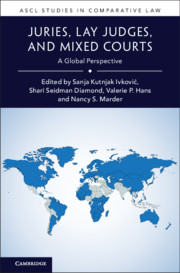Book contents
- ASCL Studies In Comparative Law
- Juries, Lay Judges, and Mixed Courts
- Copyright page
- Contents
- Editors
- Contributors
- Acknowledgments
- 1 Introduction
- Part I Advances in Lay Participation
- Part II Enduring Systems of Lay Participation
- 7 “… And My Right”
- 8 “In the Name of the People”
- 9 The Jury in Canada
- Part III Challenges to Lay Participation in Law
- Part IV Global Perspectives on Lay Participation
- Name Index
- Subject Index
- References
9 - The Jury in Canada
Testing the Comprehensibility of Styles of Jury Instructions and the Effectiveness of Aids
from Part II - Enduring Systems of Lay Participation
Published online by Cambridge University Press: 03 August 2021
- ASCL Studies In Comparative Law
- Juries, Lay Judges, and Mixed Courts
- Copyright page
- Contents
- Editors
- Contributors
- Acknowledgments
- 1 Introduction
- Part I Advances in Lay Participation
- Part II Enduring Systems of Lay Participation
- 7 “… And My Right”
- 8 “In the Name of the People”
- 9 The Jury in Canada
- Part III Challenges to Lay Participation in Law
- Part IV Global Perspectives on Lay Participation
- Name Index
- Subject Index
- References
Summary
This chapter examines the issue of how well Canadian jurors comprehend legal instructions and whether there are jury aids that can enhance their comprehension. It traces the design of the first study in Canada to assess the relative efficacy of two competing styles of instructions used in Canada and to compare them with the plain language criminal law instructions used in California, USA. The style that used a series of logical questions to be answered was associated with the highest levels of comprehension. The results also revealed that the type of aid provided had a modest impact on overall comprehension score and that those who received either both aids (written instructions and decision trees) or written instructions had scores that were significantly different from either those with no aid or the decision tree alone. This chapter also explores some of the challenges associated with cross-jurisdictional research. Additional studies are needed to ensure that jurors have an accurate understanding of the law and to make clear how styles of jury instruction and jury aids can impact comprehension levels.
Keywords
- Type
- Chapter
- Information
- Juries, Lay Judges, and Mixed CourtsA Global Perspective, pp. 174 - 194Publisher: Cambridge University PressPrint publication year: 2021



